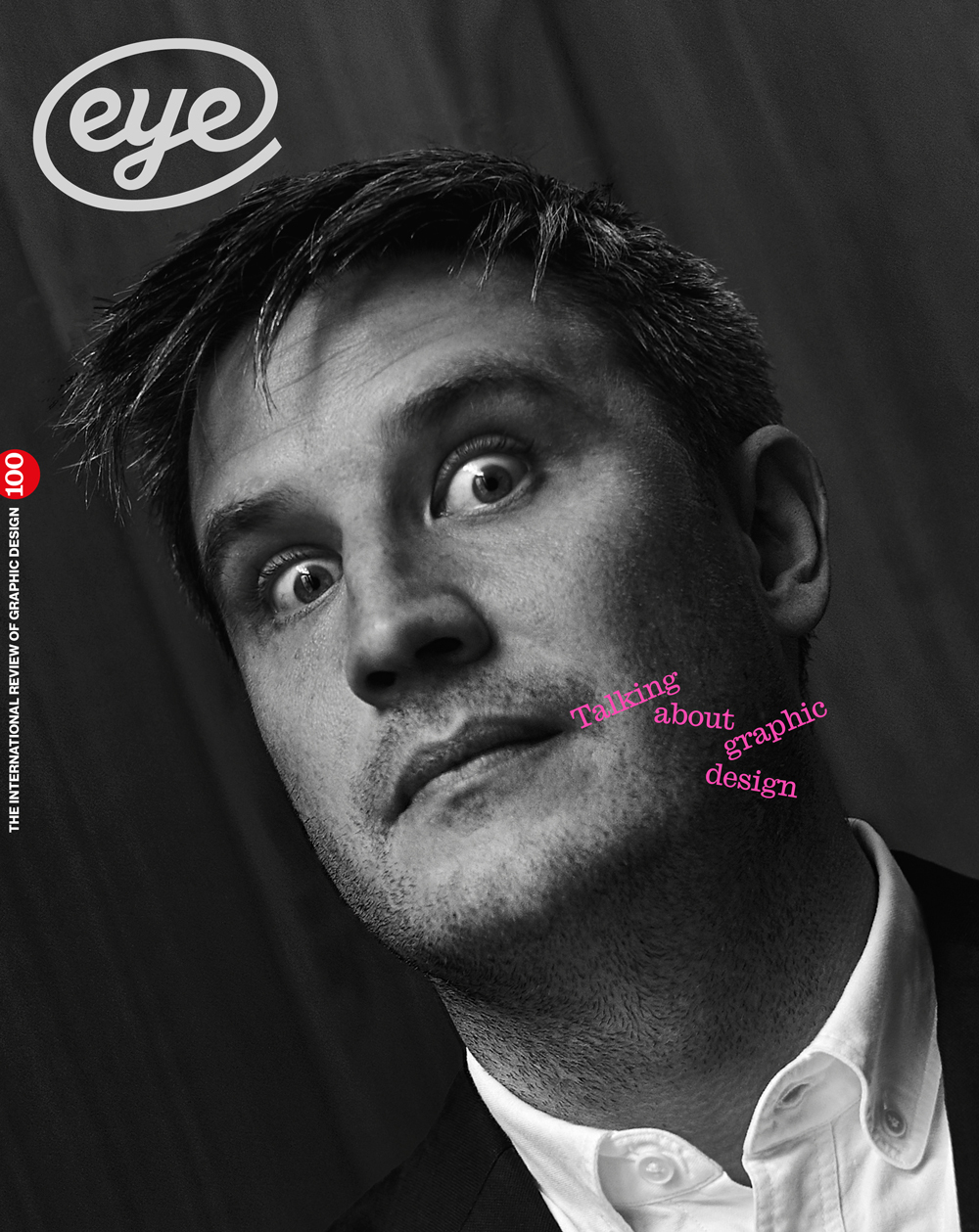Summer 2020
Eye’s early years
Founding editor Rick Poynor recalls the aims and ideas behind the launch of an independent design magazine
The first Reputations interview, with Swiss graphic designer Bruno Monguzzi, Eye 1, 1990. Portrait by Philip Sayer.

Rick Poynor edited the first 24 issues of Eye and has written the Critique column for twenty years. He contributes to many publications and co-founded Design Observer in 2003. His books include Typography Now: The Next Wave, Typographica, No More Rules, Communicate, Jan van Toorn: Critical Practice, National Theatre Posters: A Design History and the essay collections Design Without Boundaries and Obey the Giant. In 2016 he joined the University of Reading’s Department of Typography & Graphic Communication as Professor of Design and Visual Culture. His latest book, David King: Designer, Activist, Visual Historian, will be published by Yale in September 2020.
It is enormously gratifying to see Eye reach its 100th issue. When the first edition was published in November 1990 I had no idea whether the magazine would succeed in making a place for itself and gave no thought whatsoever to whether it would still be around nearly 30 years later. With ambitious production values in place right from the start, Eye was always expensive to produce. In its early days, we were living from issue to issue, wondering whether the latest edition or the next one would turn out to be the last.
Now published once again by a tight-knit team, Eye has come full circle. Its original publisher, Wordsearch, was a small independent company founded to launch Blueprint, the most adventurous and original British architecture and design magazine of the 1980s. Wordsearch had offices in a rickety old building at 26 Cramer Street in Marylebone above the 9H architecture gallery. I had joined Blueprint in early 1988 as deputy editor with a brief to write about every area of design. Blueprint was already publishing occasional articles about graphic design, with Robin Kinross as principal contributor, and I saw an opportunity to boost the magazine’s coverage of the field.
The idea for a new graphic design magazine emerged from a conversation in a local café with Blueprint art director Simon Esterson (one of Wordsearch’s directors, with publisher Peter Murray and editor Deyan Sudjic), now Eye’s co-owner. We discovered we were thinking along the same lines. Simon challenged me there and then to make a list of contents for a notional first issue.
Cover of Eye 1, 1990, features a detail from Het Boek van PTT (1930-38) by Piet Zwart.
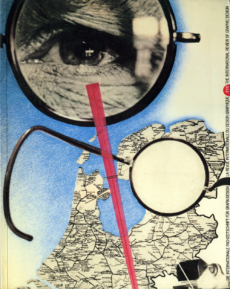
Murray and Sudjic liked the idea, but a proposal to create a customer magazine for Vitra, the furniture company, looked like it would get priority. When that fell through, the way was clear for a new graphic design quarterly. As editor, I was given remarkable freedom to develop the editorial content of the project as I saw fit and this persisted after we launched. Stephen Coates, Blueprint’s designer, would be the art director, and Vicky Wilson, also from Blueprint, would be production editor. The only bone of contention was the name. When I told Tibor Kalman about our plans on a trip to New York, he immediately proposed ‘Eye’. I liked this at once, but it was essential to the magazine’s international aspirations that the title worked abroad, since the text would be in three languages: English, French and German. Only when a marketing survey produced ‘Eye’ as the favourite was the name adopted.
Opening spread from the Eye 1 feature about Studio Dumbar’s flexible identity – then a novel idea in company communications – for the newly privatised Dutch postal service.
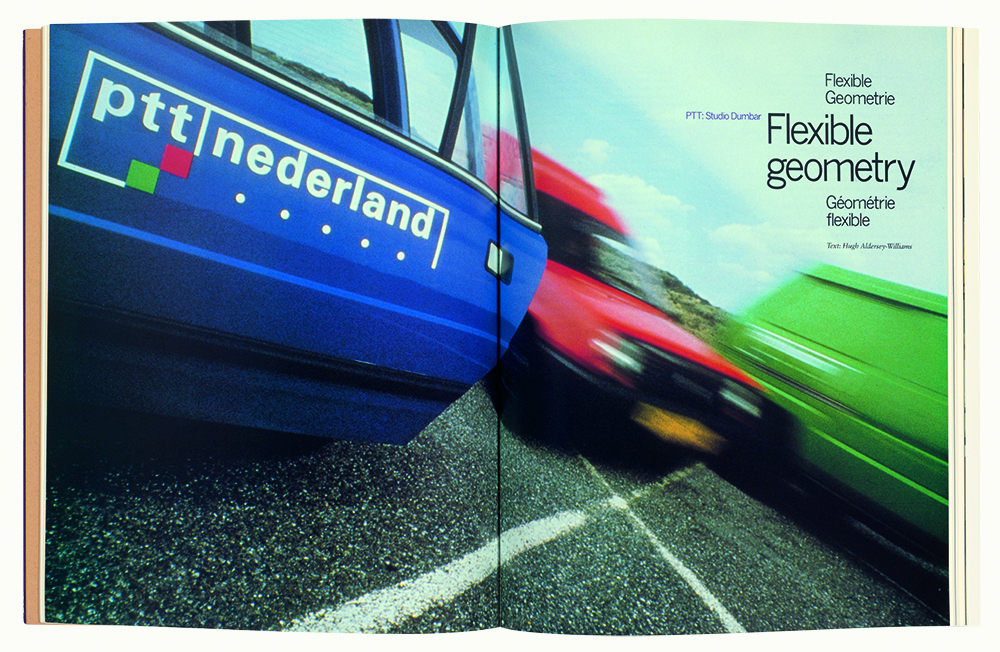
Now that printed design journalism appears to be in inexorable decline, it is worth recalling what a thriving sector it was around 1990. In Britain, graphic design coverage could be found in Creative Review (CR) and Direction (an offshoot of Campaign), both monthlies, and in Design, Design Week (launched in 1986), Baseline, 8vo’s eight-issue Octavo, Graphics World, Hot Graphics International (which later shed the ‘Hot’ and eventually became Grafik), TypoGraphic, published by the International Society of Typographic Designers and Designer, published by the Chartered Society of Designers. Trade journalism provided the template for much of the writing in these publications and any new title would need to offer something different. In the leading titles, CR and Direction, articles tended to occupy two to four pages with only a handful of illustrations. The main content comprised news stories, profiles, trend pieces and a limited amount of opinion. The two magazines’ remit to cover the businesses of both advertising and graphic design led to an inevitable lack of focus on design.
It would be unfair to underplay the importance of these titles as sources of information – CR, launched in 1980, had piqued my emerging interest in graphic design and it published my first design press articles. But the primary British inspiration for Eye was Herbert Spencer’s Typographica, launched in 1949, which had published its final issue in 1967. Spencer assembled lavishly illustrated articles covering many pages, especially in the magazine’s second series. His twice-yearly journal introduced important historical subjects alongside features about significant new design. Typographica (see Eye 31) was also beautifully designed and printed; no-one would throw it away.
Eye 4, 1991. Opening spread of a feature about designer Robert Brownjohn (1925-70) by Katy Homans.
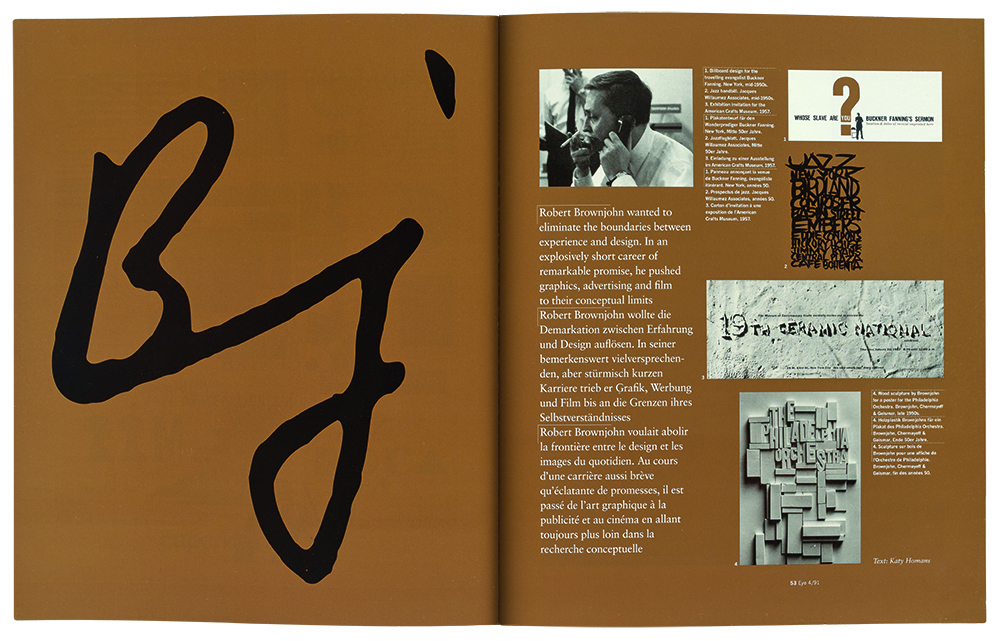
The contemporary design publications that interested me most were American. Under its long-serving editor Martin Fox, Print magazine (founded in 1940) set the highest possible editorial standards, while Rudy VanderLans’ Emigre – still getting started on its design mission in 1990 – was already making an unmissable contribution to design culture. The AIGA Journal, edited by Steven Heller, was also a vital forum for debate.
Eye’s immaculate standards of page design, repro and printing attracted attention immediately. They made the 96-page magazine look confident and serious and much more firmly established than it was. (Financial security did not arrive until issue 13 in 1994 when the commercial publisher Emap acquired us – a merciful release for Wordsearch. Emap kept its promise to me to honour our idiosyncrasy and left us unchanged.) Eye’s initial design style was purposely restrained; the graphic impact would come from the carefully presented content. Our original masthead was tiny (too tiny) and we pointedly avoided cover lines and placing ads on the inside covers or the back cover. The ‘internationalism’ of Eye’s positioning and its trilingual pages were likewise intended to set the venture apart. We also thought this breadth of appeal was essential to sales, since Eye cost a hefty £10. In practice, our view of the design world remained very Euro-American, but this was still markedly different from the usual, primarily British perspective. The first issue featured subjects from Switzerland, the Netherlands (two features), Germany, Eastern Europe and the United States, and only one British article (about television graphics). The reviews section, always an essential section in Eye, covered US information design and design history, and Chinese graphics.
As Eye developed over the next two or three years, it became more orientated towards American readers than European ones. By Eye 7 in 1992 we had dropped the French and German translations, allowing space for longer texts – which had always been the aim. The most vigorous debates around new technology and design were happening in the US and American writing about graphic design was more developed at that point. Eye’s writers were just as likely to be practitioners as journalists, and North American contributors such as Michael Rock, Ellen Lupton, Abbott Miller, Anne Burdick, Will Novosedlik and Jessica Helfand helped to define Eye’s purview and stance.
Publishing only four issues a year, we could afford to be highly selective in the material we featured. Contemporary subjects needed to be setting the agenda in some way. It was not enough for a designer to be merely ‘good’ or well established in a conventional vein. My visual interests were eclectic, but whatever the style, I favoured designers with a well defined position, clearly articulated values and fresh ideas. The ‘Reputations’ interviews – Q&As were unusual in design journalism then, and Blueprint always avoided them – were reserved for leading lights who could talk illuminatingly about their thinking and work. The 1980s had been a decade in which graphic design was heavily discussed and promoted – over-promoted – as a business endeavour. There was no reason to duplicate this effort and we sought from the outset to put the emphasis firmly on graphic design as a form of cultural practice. Artists and architects had long benefited from this kind of self-awareness. If graphic design was as significant as designers liked to believe, then discussion of its purposes, practices and possibilities needed to be much more explicit, rigorous and probing.
An understanding of graphic design’s rich history was key to this aim. Eye featured historical subjects ripe for rediscovery and reappraisal from the first issue. (Print’s commitment to history was a key influence here.) We were interested in the limitations of design history, as it had been written about up to that time, and the uses to which it could be put in the present. Other recurrent concerns in those early years included debates surrounding Modernism and postmodernism, the role and limits of experimentation, the changes brought about by digital technology, the importance of writing to design practice, the potential of design authorship, the often-overlooked contribution of women, and the social meaning and responsibilities of design – not, in those years, receiving much attention. Andrew Howard’s ‘There is such a thing as society’ (Eye 13) is one of the articles I am most proud to have given a home in Eye.
Andrew Howard’s probing inquiry into design’s social purposes helped revive interest in the 1964 ‘First Things First’ manifesto. Adbusters magazine saw the piece and it led to the publication of ‘First Things First 2000’ across several design magazines (including Eye) worldwide in 1999.
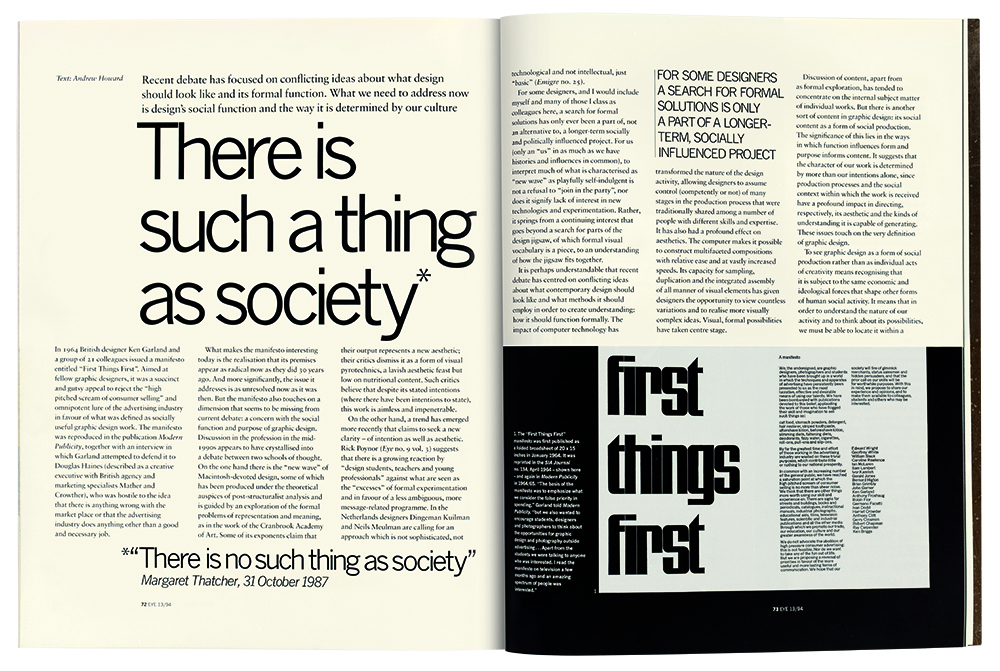
Eye 20 (1996) was a special issue devoted to ‘The designer as author’. Michael Rock’s article remains one of the key statements on this topic and it has been frequently re-published.
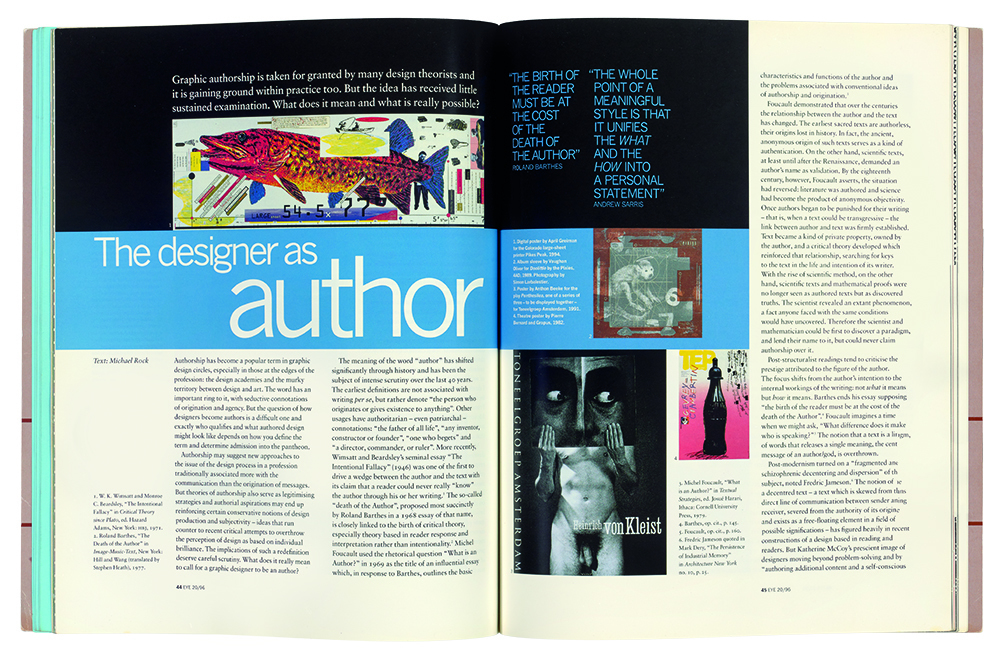
Underpinning all of this was a belief that graphic design required not only journalism (of which there was plenty) but its own form of criticism. In the US, this need had been clearly stated by the early 1990s, but ‘graphic design criticism’ was not a term heard in Britain back then. My dialogue with Michael Rock, ‘What is this thing called graphic design criticism?’ (Eye 16), was an attempt to make the magazine’s critical intentions explicit, essential if the idea was going to take hold and flourish. This kind of critical writing requires conviction, detachment and a degree of robustness. Twenty-five years later, we might ask whether the need was ever entirely accepted within the profession, or the goal convincingly achieved. Nevertheless, Eye provided a platform for seasoned writers such as Robin Kinross, Richard Hollis, William Owen, Liz Farrelly, Julia Thrift and Steven Heller, whose feature ‘Cult of the ugly’ (Eye 9) provoked a transatlantic furore. It also gave space to first or early pieces by writers such as Teal Triggs, Adrian Shaughnessy and Eric Kindel.
In the 1990s, many of the changes we now take for granted in graphic design were still in the process of emerging. Eye’s early pages were a place to investigate these ideas and explore their potential; there was much to discover and discuss. For me, as Eye’s first editor, they were hugely stimulating and exciting years.
Stephen Coates’s cover design for Eye 11 (1993), one of the magazine’s annual typography special issues.
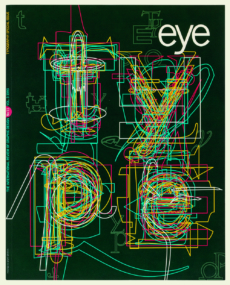
For Eye 24 (1997), Rick Poynor’s final issue as editor, Coates pieced together a caustic collage of newsstand cover lines to illustrate Caroline Roux’s feature about the laddish new sexism flourishing in men’s magazines.
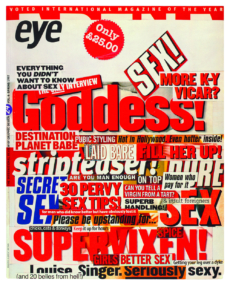
Rick Poynor, writer, Eye founder, Professor of Design and Visual Culture, University of Reading
First published in Eye no. 100 vol. 25, 2020
Eye is the world’s most beautiful and collectable graphic design journal, published for professional designers, students and anyone interested in critical, informed writing about graphic design and visual culture. It is available from all good design bookshops and online at the Eye shop, where you can buy subscriptions and single issues.
Links
eyemagazine.com
‘Reputations: Bruno Monguzzi’ in Eye no. 1
‘Bj’ in Eye no. 4
‘Cult of the ugly’ in Eye no. 9
‘There is such a thing as society*’ in Eye no. 13
‘What is this thing called graphic design criticism?’ in Eye no. 16
‘The designer as author’ in Eye no. 20
‘The portable art space’ in Eye no. 22

